4400 Wilshire Blvd. and 4401 W. 8th St. Los Angeles, CA 90005 | map |
Also see: Wilshire Ebell backstage
Opened: December 29, 1927 as the Windsor Square Theatre with a production of Sigmund Romberg's "The Desert Song." It's four blocks west of Crenshaw on the south side of the street. We're looking at the theatre's entrance on 8th St., around on the back of the building. Photo: Bill Counter - 2010
Phone: 323-939-0126 Websites: www.ebellla.com | www.wilshireebelltheatre.org
Architects: Sumner P. Hunt and Silas R. Burns designed the building for the Ebell of Los Angeles Women's Club. In
addition to the theatre, the complex includes many club rooms, offices
and a ballroom. The main entrance is on Wilshire Blvd.
A sketch of the building by Hunt and Burns that's on display in the theatre's Club Foyer, a lobby that stretches along the house right side of the auditorium.
A plan of the theatre. The rest of the building is off to the right with Wilshire Blvd. beyond. Thanks to Mike Hume for locating this. See the Wilshire Ebell page on his
Historic Theatre Photography site for many of his fine photos of the theatre.
Another version of the plan annotated to show fire safety items. This one, on display in the Club Foyer, was drawn in 1954 by F.W. Jamison.
The theatre portion of the building was described in first issue of the new Ebell Magazine, dated October 1927:
The issue was titled "Dedication" and can be seen as a
PDF from the Los Angeles Public Library. Thanks to Etan Rosenbloom for locating this. He included a link to it on his
Etan Does LA page about the Ebell.
A drawing that appeared in the December 25, 1927 issue of the L.A. Times. Thanks to Mike Hume for locating it.
An article appearing in the December 28 issue of the Times.
The conclusion of the December 28 Times article.
The December 28 Times ad for "The Desert Song."
The considerably smaller opening day ad in the Times: December 29, 1927.
Seating: 1,266 currently with 883 on the main floor and 383 in the balcony. In 1949 it was listed as 1,294 with 911 of that on the main floor and 383 in the balcony.
The Stage: The proscenium is 39' wide x 27' 3" high. The depth is
31' 2" from the proscenium plasterline to the back wall. The orchestra
pit (when covered) adds another 6' 1". It's 5' from the footlights to
the house curtain and 30' from the curtain to the backwall. Stage wall
to wall is 85'. Wingspace stage left is 12', with some restrictions.
Stage right it's 8'. The counterweight system has 34 wire-guide sets,
all but one operated at stage level stage right. The grid height is 60'.
There's a flyfloor stage right. It was designed as a hemp house. See
the backstage page for details and many photos.
Pipe Organ: It's a 3/13 Barton that's owned and maintained by the Los Angeles Theatre Organ Society. When the theatre opened the chambers were empty. It was noted in the October 1927 issue of the club's magazine: "Flanking the proscenium on each side are two organ lofts, where some day a mighty organ will be installed."
The console of the Barton. Thanks to Kevin R. Cartwright for the photo.
The relay board in the room below the house left chamber. Photo: Mike Hume - 2023
Another relay view. Photo: Mike Hume - 2023
A small part of the gear in the house left chamber. Photo: Mike Hume - 2023
In the house right chamber. Photo: Mike Hume - 2023
Another house right chamber view. Photo: Mike Hume - 2023
History: The theatre didn't get a separate listing in the 1928 city directory but the club was listed with a 4400 Wilshire
address. In 1929 and 1930 it was listed as 743 S. Lucerne Blvd. In the 1929, 1930 and 1931 city directories there are listings for the Windsor Square Theatre at 4401 W. 8th St.
Mike Hume notes that "The Desert Song," the theatre's inaugural production, closed after a three week run and was moved to the Mason Theatre downtown. Initially the stated reason was that the production needed more seats. At least that was mentioned in the L.A. Times article on January 22, 1928 titled "'Desert Song' moves from Windsor
Square to Mason." In "Club Theater Lessee Denies Suit for
Rent," a February 11 Times article that Mike located, it was stated that one factor in the show's closure had been complaints from neighbors.
Evidently there were no further public events at the theatre until March when an ad appeared in the Times on the 4th for a production of "Abraham
Lincoln," a company from New York "sponsored" by the Ebell Club that ran for a week beginning March 12. For the next eight months the bookings were low-key. There were regular rentals for church services and occasional one-night events such as "The Belle of
Barcelona" in October and a USC student revue in late 1928.
Although it hadn't been totally dark, an article in the December 27, 1928 issue of the Times talked about a "reopening." The page 13 story "'Pierre of Plains’ In New Debut" discussed the theatre's reopening and "resuming its place on the Los
Angeles theatrical map." The article goes on to say that the theatre
"has housed but one major theatrical attraction heretofore: 'The Desert
Song.'"
"Not a Movie." This ad for "Pierre of the Plains" also appeared in the December 27, 1928 issue of the Times. Thanks to Mike Hume for dating the ad, locating the story, and researching the other early events.
In the 1932 directory it's become the Wilshire Ebell Theatre, again
with the 8th St. address. That year W.T. Wyatt is listed as manager. One of his jobs much earlier had been as business manager of the Seaside Theatre in Ocean Park, a house that opened in 1905. He was the son of Henry Clay Wyatt (1849-1910) a legendary impresario who at various times had operated the Mason Opera House, the Grand Opera House and the Lyceum Theatre.
Judy
Garland (then Francis Gumm) supposedly had her first audition at the
Wilshire Ebell and was later "discovered" while performing here.
Two nights of vaudeville in 1935 and 1936 under the auspices of the Federal Theatre Project. Thanks to Lucian Tomes, Jr. for sharing this poster he located on the
Vaudeville! Facebook page.
In 1937
Amelia Earhart made her last public appearance at the Ebell before
embarking on her last flight.
A Federal Theatre Project production of "Pinocchio" at the theatre in 1938. Thanks to Jonathan Raines for locating this in the
Library of Congress collection. Also see a
flyer for the production.
Status:
This club and theatre, located in the affluent Hancock Park area, has
always been a popular venue. The club is thriving with the theatre as well as other ballrooms and
meeting spaces rented out for a variety of events. The organization does no presenting. It's exclusively a rental venue.
The club foyer:
This space stretches along the house right side of the auditorium and
serves as an entrance lobby for patrons coming to the theatre from the
main building, the courtyard, or off Lucerne St. Here we're looking toward the back of the house. The stairs behind the railing go down to the front exit from the auditorium. Photo: Bill Counter - 2022
Rotating 180 degrees from the previous photo to look at the landing and out to the colonnade along the east side of the courtyard. Photo: Bill Counter - 2022
A closer look at the wood and glass structure seen on the left in the previous photo. It's a boxoffice with a telephone booth on the far end. Photo: Bill Counter - 2022
Another angle on the phone booth and boxoffice. Thanks to Joanna Westerholm Linkchorst for sharing her photo in a
Facebook post that included 18 views of the theatre taken during the Ebell September 18, 2022 open house.
Also of interest at the top landing is this corridor running behind the back wall of the stagehouse. Off to the right it's offices and restrooms. The stairs in the foreground, as well as another set this side of the firedoor at the end, lead to a similar corridor a floor above as well as access to the 3rd floor Solarium, Terrace and Fine Arts Theatre. The firedoor gets you into the backstage stairwell and
either down to the stage or up to several floors of dressing rooms. Photo: Bill Counter - 2022
Down at the main lobby end of the foyer looking back to the landing at the stage end of the space. Photo: Bill Counter - 2022
A fixture on the west wall this side of the entrance to the theatre's cross aisle. Thanks to Michelle Gerdes for sharing her photo. It was part of her
Ebell of Los Angeles Facebook post of 10 views taken at the organization's September 18, 2022 open house.
At the lobby end of the Club Foyer, getting a peek across the main lobby. At the far end we're looking into the ladies lounge. Two entrances to the auditorium are behind red drapes on the right side. Photo: Bill Counter - 2022
The main lobby:
The lobby space at the back of the auditorium. The brightly lit arch on the left is in the Club Foyer. The doors on the right are the theatre's main entrance on the south end of the building, toward 8th St. Photo: Dave PD -
Photos of Los Angeles - Facebook - 2003
A wider view from house left. Thanks to Mike Hume for sharing this 2023 photo as well as the many others appearing here. See the
Wilshire Ebell page on his
Historic Theatre Photography site for tech information, history and many additional photos.
Looking across from house right. Photo: Bill Counter - 2022
A peek into the ladies room. There are also restrooms upstairs for both ladies and men. Photo: Bill Counter - 2022
Another look into the ladies lounge. Photo: Bill Counter - 2022
A wider view of the house left end of the lobby. Photo: Bill Counter - 2022
An elegant peek into the auditorium. Photo: Mike Hume - 2023
The balcony lobby:
Looking into the house right vomitory. Photo: Bill Counter - 2022
The balcony corridor from house right. The lounge is to the left. Photo: Bill Counter - 2022
The balcony lounge with the ladies room doorway at the left. Photo: Bill Counter - 2022
The ladies lounge. Photo: Bill Counter - 2022
Looking into the ladies sink and toilet room. Photo: Bill Counter - 2022
The ladies toilet area. Photo: Bill Counter - 2022
A peek into the men's room on the house right end of the lounge. Photo: Bill Counter - 2022
Looking out to the small vestibule. The lounge area is beyond. Photo: Bill Counter - 2022
The house left stairs to the main floor. Photo: Bill Counter - 2022
On the main floor:
A peek in from the rear of the main floor. There's a door over near the front exit on the right that gets you backstage. Photo: Dave PD -
Photos of Los Angeles - 2003
A look in toward the theatre's 1927 vintage fire curtain. Photo: Mike Hume - 2023
A proscenium view from the rear of house right. Photo: Mike Hume - 2017
A photo from the
Ebell Club website.
A closer look at the proscenium. Photo: Marianne Lozano Photography /
Biz Bash
A view of the fire curtain from the center of the house. Photo: Bill Counter - 2023
A corner detail. Photo: Mike Hume - 2023
The center medallion. Photo: Mike Hume - 2023
The rear of the auditorium. Photo: Bill Counter - 2022
Another look to the rear. Photo: Marianne Lozano Photography /
Biz Bash
Under the balcony. Photo: Marianne Lozano Photography /
Biz Bash
One of the soffit fixtures. They're also air returns. Photo: Joanna Westerholm Linkchorst - 2022
Up in the balcony:
A panoramic view across at balcony level. Photo: Wendell Benedetti - Los Angeles Historic Theatre Foundation - 2015. Thanks, Wendell! The photo originally appeared on the
LAHTF Facebook page.
Looking along the cross aisle. That's the door to the booth at the head of the far aisle. Photo: Bill Counter - 2022
A view from house left. Photo: Marianne Lozano Photography /
Biz Bash
A look down from in front of the booth. Photo: Mike Hume - 2017
Another look at the fire curtain. Photo: Mike Hume - 2023
The ornament above the proscenium. Photo: Mike Hume - 2023
The stage from house right. Photo: Mike Hume - 2019
Ornament above the house left organ chamber. Photo: Bill Counter - 2022
Across from the front house right. Photo: Bill Counter - 2022
A c.1927 Mott Studios photo from the
California State Library collection. The ports have been opened up a bit.
Up in the booth:
Looking out the door on the house right end of the booth. Photo: Mike Hume - 2019
The booth stairs and a rewind/film storage cabinet. Photo: Bill Counter - 2022
Looking to the house left end of the booth. Photo: Bill Counter - 2022
The Westinghouse motor-generator set in the room at the left end of the booth. Photo: Bill Counter - 2022
The DC switchboard on the back wall. Photo: Bill Counter - 2022
A porthole view. Photo: Bill Counter - 2022
Looking back across from the house left end of the booth. Photo: Bill Counter - 2022
Backstage:
Looking onstage from behind the wire-guide counterweight sets. Photo: Mike Hume - 2017
See the
backstage page for a full exploration of the stage, grid, stage basement and dressing room areas.
Many thanks to Matthew Schroeder, the theatre's Director of Production, and Erika Newman, the theatre Business Manager, for their courtesy in allowing explorations of the building.
More exterior views:
1926 - A fine construction view commissioned by Scofield Engineering and Construction. It's on display in the theatre's Club Foyer, a space running along the house right side of the auditorium.
1927 - The building nearing completion. Thanks to Eric Lynxwiler for sharing this photo from his collection on
Flickr.

1927 - A photo from the Herald Examiner collection of the
Los Angeles Public Library. We're looking south from Wilshire with the main building in front, the theatre in back.
c.1927 - The east side of the building as we look north toward Wilshire. It's a Mott Studios photo in the
California State Library collection.
c.1927 - Another shot from the Mott Studios in the
California State Library collection, this time looking southwest from Wilshire.
The Library's collection includes these c.1927 Mott Studios photos of the building: 1 courtyard photo - #
001385922 | 2 courtyard photos - #
001386168 | 4 lounge photos - #
001386234 | 7 photos: lounge, exterior views - #
001416450 | 1 corner exterior photo - #
001424635 | 3 photos: courtyard and exterior - #
001535358 | 16 photos: 1 of theatre + other areas - #
001535367 | Also:
Wilshire facade - William Reagh - 1989
1929 - Another view from the Herlick Studio that's in the
Los Angeles Public Library collection. The theatre entrance is over on the left.
1937 - A photo taken by Dick Whittington when the theatre was known as the Windsor Square Theatre. It's in the Herald Examiner collection at the
Los Angeles Public Library. The
USC Digital Library also has a copy, where they date it as 1939.
1939 - A photo of a house moving project with the Ebell in the background. It's in the Herald Examiner collection of the
Los Angeles Public Library.
1954 - Thanks to Richard Wojcik for this view of the Ebell from his collection. It was a post on the Facebook page
Vintage Los Angeles.
c.2010 - Around back at the theatre entrance. It's a photo by Martin that appeared on his now-vanished site You-Are-Here.com.
2010 - Looking along the Lucerne side of the building. Photo: Bill Counter
2010 - The corner at Wilshire and Lucerne Blvd. Photo: Bill Counter
2010 - The Wilshire side of the building. Photo: Bill Counter
2017 - Another view of the Wilshire facade. Photo: Mike Hume
2017 - The sign after a paint job. Photo: Mike Hume
2017 - Another view of the theatre entrance. Photo: Mike Hume
2020 - The lights were on for Red Alert Day, September 1 to call attention to the plight of arts organizations that have been devastated by the effects of the Coronavirius shutdown. Thanks to Mike Hume for this shot and all the other fine views appearing
on the page. For more of his work see the Ebell Theatre page on his
Historic Theatre Photography site.
2022 - A look toward the theatre. Thanks to Suzanne Wilton for sharing her photo on the
Photos of Los Angeles Facebook page.
2022 - A view north along the house left exit passage that's on the west side of the building. The stage door is at the end. Photo: Bill Counter
2022 - A closer look at the dressing room stack. Photo: Bill Counter
2022 - A peek over the railing toward the stage door. Photo: Bill Counter
2023 - Looking down into the courtyard from one of the smoke vents just below the roof of the stagehouse. Thanks to Mike Hume for his photo. See many more of his photos on the
backstage page.
The Ebell in the Movies:
John Barrymore runs onstage in a panic in his New York theatre when he
realizes the star he's created, played by Carole Lombard, has abandoned
him to go to Hollywood in the Howard Hawks comedy "20th Century"
(Columbia, 1934). Nearly the first twenty minutes of the film was shot
at the Ebell plus a return at the conclusion. See the
Historic L.A. Theatres in the Movies post for ten more shots from scenes at the Ebell.
Katherine
Hepburn
is coming down the house left aisle in Phillip Moeller's film "Break of
Hearts" (RKO, 1935). The Ebell is supposedly a
concert venue in New York and her husband, Charles Boyer, is conducting.
Like the marriage, the concert doesn't go well. He shows up late and
drunk. See the
Historic L.A. Theatres in Movies post for more shots at the Ebell from the film.
Fred
Astaire is coming onstage to take the baton from Artie Shaw for a
number
toward the end of "Second Chorus" (Paramount, 1940). Also featured are
Paulette Goddard, Burgess Meredith and Charles Butterworth. H.C. Potter
directed. The cinematography was by Theodor Sparkuhl. See the
Historic L.A. Theatres in Movies post for a shot up in the Ebell balcony as well as two backstage views that were shot elsewhere.
The theatre is used for a political rally in "The
Farmer's Daughter" (RKO, 1947).
H.C. Potter directed this sweet tale of farm girl Loretta Young coming
to wicked Capitol City, taking a job as a maid and somehow getting
elected to Congress. The film also stars Joseph Cotten, Ethyl Barrymore
and Charles Bickford. See the
Historic L.A. Theatres in Movies post for five more shots from the scene at the Ebell.
Joseph Cotten and Ethel Barrymore go to a concert at a New York theatre
in William Dieterle's "Portrait of Jennie" (Selznick, 1948). Cotten is
obsessed with a young girl played by Jennifer Jones who appears to him
at random intervals and each time she's a few years older. He says
"Everything reminds me of Jennie" and leans forward to stare intently at
the stage.
I leaned forward as well but not because of Jennie. In this shot
everything reminded me of footage I'd seen before. Yes, that conductor
reminded me of Charles Boyer. Why, it is Charles Boyer. And the audience
is the same one that was there in scenes at the end of the 1935
RKO film "Break of Hearts," footage reused for this film. See the
Historic L.A. Theatres in Movies
post for a shot of Cotten and Barrymore up in the balcony. Well, most
likely those shots were done on some risers at the studio.

Diana
Ross takes a bow as Billie Holiday near the end of "Lady Sings the
Blues" (Paramount, 1972). The Ebell is standing in for Carnegie Hall.
Sidney
Furie directed the film which also features Billy Dee Williams, Richard
Pryor, James T. Callahan, Paul Hampton, Sid Melton, Virginia Capers,
Yvonne Fair and Scatman Crothers. The cinematography was
by John Alonzo. See the
Historic L.A. Theatres in Movies post for several more shots from the Ebell shoot as well as views of a number filmed at the Follies Theatre on Main St.

The Ebell is seen as tryout theatre in New Haven in
"Mame" (Warner Bros., 1974). Bea Arthur is onstage for the number "The Man in the Moon (is a
Lady)." She's given Lucille Ball a job as the moon girl. Thanks to Kevin Miller for spotting the theatre in
the film. Usually we don't see their proscenium painted red and gold. The film also features Robert Preston, Bruce Davison, Jane Connell and George Chiang. Gene Saks directed, based on the musical by
Jerome Lawrence, Robert E. Lee and Jerry Herman. The film's cinematography was
by Philip Lathrop. See the
Historic L.A. Theatres in Movies post for twelve more views at the Ebell of this number and one that follows. There are also two shots from an earlier scene at the Follies on Main St.

Gary Busey, Charlie Martin Smith and Don Stroud backstage at
the Ebell as Buddy Holly and the Crickets in "The Buddy Holly Story"
(Columbia, 1978). Steve Rash directed the
film. The theatre is used as the Apollo in New York as well as for
another theatre on the road. Two theatres in Atlanta were used for
exterior shots. See the
Historic L.A. Theatres in Movies post for more shots at the Ebell from the film.
The Ebell was the venue they used when Richard Dreyfuss plays in a piano competition Cincinnati in "The Competition"
(Columbia, 1980). The film also stars Amy Irving, Lee Remick, Sam Wanamaker, Ty Henderson, Joseph Cali, Vicki Kriegler, Adam Stern
and Gloria Stroock. Joel Oliansky directed. The cinematography was by
Richard H. Kline. See the Historic L.A. Theatres in Movies post for a shot of Drefuss at the piano at the Ebell plus a bit more about the movie.
The theatre was used for the 1985 TV special "Musical Comedy Tonight III."
When Ritchie Valens (Lou Diamond Phillips) goes to New York to play the
Brooklyn Paramount in the Luis Valdez film "La Bamba" (Columbia, 1987),
the Wilshire Ebell is used for the interiors. See the
Historic L.A. Theatres in Movies
post for more views of the Ebell from the film. For the exterior views
the film uses some footage of the Wiltern that was shot for "American
Hot Wax" in 1977.
Meryl Streep is onstage as an aging Broadway star in an over-the-top production number in a musical adaptation of
"Sweet Bird of Youth" in "Death Becomes Her" (Universal, 1992). Yes, the show is so bad that customers are leaving. Thanks to Mike Hume for spotting the theatre in the film, which also stars Goldie Hawn, Bruce Willis and Isabella Rossellini. It was directed by Robert
Zemeckis and written by Martin Donovan and David Koepp. The
cinematography was by Dean Cundey. See the
Historic L.A. Theatres in Movies post for three more shots from the scene at the Ebell.

The Ebell stands in for the Ed Sullivan Theatre in "Mr. Saturday Night" (Columbia, 1992). The comic played by Billy Crystal has been waiting a year for this -- only to find that he's on right after the Beatles and nobody will pay any attention to him. Crystal directed from a script he wrote with with Lowell Ganz and Babaloo Mandell. The cinematography was by Don Peterman. Also starring are David Paymer and Julie Warner. See the Historic L.A. Theatres in Movies post for another shot from the Ebell scene as well as views of two unidentified venues.
In addition to the theatre, other areas of the building are also seen in
many films and TV shows. Some Ebell spaces are seen in "The Addams Family" (Paramount, 1991). Tom Hanks briefly plays ping pong on the third floor terrace in "Forrest Gump" (Paramount, 1994). We spend a lot of
time with Richard Dreyfuss and Jenna Elfman in the main ballroom and
other areas at the end of "Krippendorf's Tribe" (Touchstone, 1998).
The
ballroom is used for a party at Harvard near the end of the stoner film
"How High" (Universal, 2001). Jesse Eisenberg is at an a cappella
performance in the ballroom in "The Social Network" (Columbia, 2010). The building is seen as office areas in "Being the Ricardos" (Amazon, 2021). Music video use includes Taylor Swift's "I Bet You Think About Me" (2021) and Charlie Puth's "One Call Away" (2022).
More Information: See the Wilshire Ebell page on Mike Hume's Historic Theatre Photography site for his fine photos of the theatre as well as lots of historical data. Check out Etan Rosenbloom's page about the Ebell on his blog Etan Does LA.
Jennifer Steinhauer's August 2010 New York Times Article "A Sanctuary for Women, Even Today" has a a nice history of the club and its activities. Danni Bayles Yeager's Performing Arts Archive has a program for a 1940 production of "Our Town" at the Wilshire Ebell.
There's a nice post (#3500) on Noirish Los Angeles with photos and discussion of the Ebell. And check in with post #3508 and post #3509 for photos of other Ebell clubs in the Los Angeles Area.
There
was an earlier Ebell Club at
1719 S. Figueroa St. downtown. And one even before that on Broadway.
Prior to the Broadway clubhouse, the ladies evidently had a rental
adjacent to a church. There was also an Ebell Club in Long Beach. The
theatre at that club got rented out to become a commercial movie
theatre, the Metro.
The Wilshire Ebell Theatre pages: back to top - main page | backstage |
| Westside theatres | Hollywood | Westwood and Brentwood | Along the Coast | Westside theatres: alphabetical list | Westside theatres: by street address | Downtown theatres | [more] Los Angeles movie palaces | Los Angeles theatres - the main alphabetical list | theatre history resources | film and theatre tech resources | contact info | welcome and site navigation guide |







































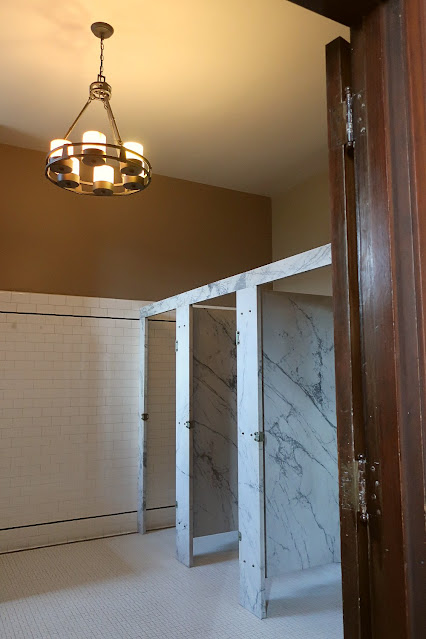


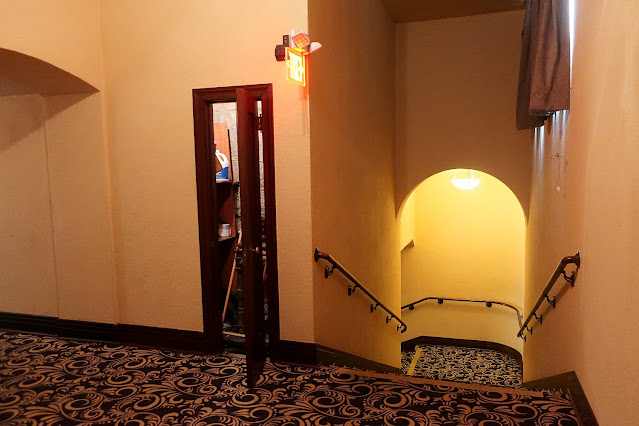






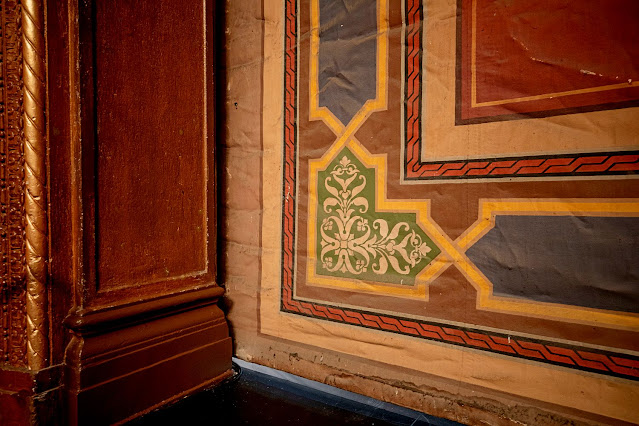
























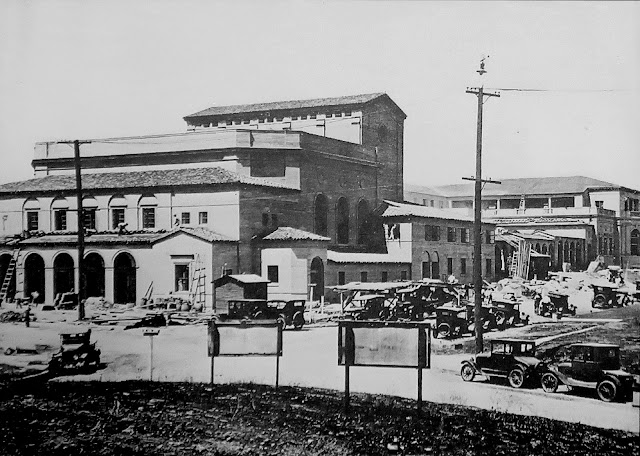





















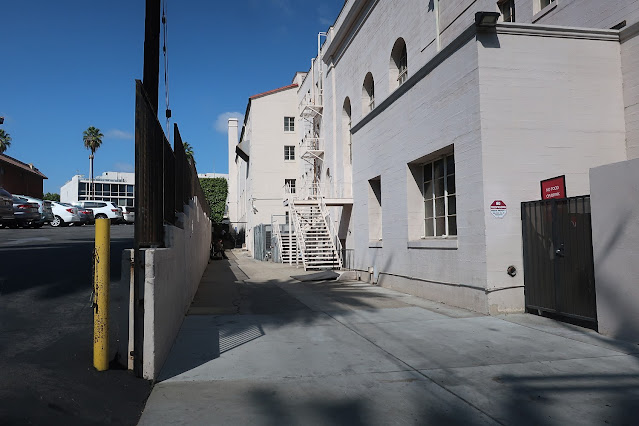















The Wilshire Ebell is a theatre everyone should visit at least once. Such a refined experience, especially if combined with the Ebell itself. A class organization. It is a trip to another time. Thanks Bill for this page.
ReplyDelete